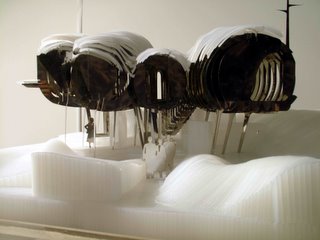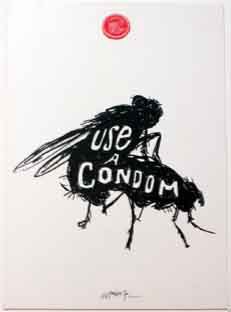
Engage (commissioned/created by Erik Adigard, a designer working with such companies as Apple, Microsoft and Sony, also engaged in new media art projects) shows some possibilities of a politically and socially active design. It is a large collection of posters whose authors look at the world in a critical way. Neutrality is not welcome here. A surprising combination of photos or an ambiguous drawing are the weapons in a fight for putting into doubt what we often unconsciously accept. “The designer stopped being a craftsman. He has become an agitator”, Adigard said during one of the conferences that accompanied the biennale. But a greater power requires greater knowledge. Influential agitators can be dangerous. That’s why the best designers know how to distinguish Coca-Cola from cocaine, and Bush from Bin Laden. In this sense, Catalysts! is an appeal not to spectators, but to designers: Go study!
world in a critical way. Neutrality is not welcome here. A surprising combination of photos or an ambiguous drawing are the weapons in a fight for putting into doubt what we often unconsciously accept. “The designer stopped being a craftsman. He has become an agitator”, Adigard said during one of the conferences that accompanied the biennale. But a greater power requires greater knowledge. Influential agitators can be dangerous. That’s why the best designers know how to distinguish Coca-Cola from cocaine, and Bush from Bin Laden. In this sense, Catalysts! is an appeal not to spectators, but to designers: Go study!
 author Rob Schröder found “fascinating, important, strange, disgusting or simply shocking” during his 40-year TV-watching marathon, staring at three screens at once. This part is appropriately called Moral Panic. This is where most of the visitors gather. They stand quietly against the walls, waiting for a scene that would give it all any sense.
author Rob Schröder found “fascinating, important, strange, disgusting or simply shocking” during his 40-year TV-watching marathon, staring at three screens at once. This part is appropriately called Moral Panic. This is where most of the visitors gather. They stand quietly against the walls, waiting for a scene that would give it all any sense.
ExperimentaDesign is not too interested in new technologies. The porcelain with designs made through a changing projection, or objects for using the internet without a computer, win the viewers through their creativity and charm. From a technical point, they aren’t quite revolutionary. The projects shown at the biennale also often seem unpractical, or difficult to use - as the strange “futuristic” architectural projects at the Portuguese Houses exhibition.  But EXD isn’t afraid of risk: all the twelve projects will be realized in a special experimental village. They are to cost no more than the average price of real estate of a similar size in this region.
But EXD isn’t afraid of risk: all the twelve projects will be realized in a special experimental village. They are to cost no more than the average price of real estate of a similar size in this region.
One could criticize many things about the ExperimentaDesign. For one, the biennale “headquarters”, in a wonderful, decaying palace downtown with a view on the Tagus river, besides a bar (associated brand: Super Bock beer) and a small library only has “tangentials”, or accompanying exhibitions (associated brand: IKEA), not always on the highest of levels (with a few exceptions, as this poster by Kau Bernau). A work by Stefan Sagmeister commissioned as a “solo exhibit” on a city billboard (commisioned by: Super Bock) is difficult to find, and at the Catalysts! exhibition nearby (official builder: Certame) nobody knows anything. But Portuguese people are friendly, cell phones starting ringing (exclusive sponsor: Vodafone) and a friend of a friend explained how to get there. Proving that the biennale’s motto, “The Medium is the Matter”, has one crucial meaning: it’s all about communication.
A work by Stefan Sagmeister commissioned as a “solo exhibit” on a city billboard (commisioned by: Super Bock) is difficult to find, and at the Catalysts! exhibition nearby (official builder: Certame) nobody knows anything. But Portuguese people are friendly, cell phones starting ringing (exclusive sponsor: Vodafone) and a friend of a friend explained how to get there. Proving that the biennale’s motto, “The Medium is the Matter”, has one crucial meaning: it’s all about communication.
More info: www.experimentadesign.pt

1. Engage (fragment), Erik Adigard (2005); 2.Collateral Image, Jasper van der Made (2003). 3. Columbus Day, James Victore (1992). 4. Lofting House, Marcosandmarjan (2005) 5. Switzerland United Banks, Kai Bernau, Christoph Dunst (2005) - part of the "Neutrality" exhibition. 6. Use Condoms, James Victore (1999)
All photos by Verónica Fernandes.

No comments:
Post a Comment